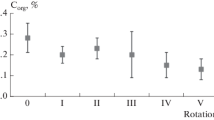Abstract
Nine field trials involving the application of35S-labelled gypsum fertilizer to various soil—pasture systems were conducted on five different soil types belonging to the New Zealand recent (Entisol) and yellow-brown earth (Inceptisol) soil groups. After application to the soil, the fertilizer sulphur (S) was converted rapidly into organic forms by microbial immobilization. Within 34 to 75 days from the time of S fertilizer application, 17 to 40% of the applied S was in organic forms in the topsoil (0–15 cm depth). A higher rate of incorporation occurred in improved pasture sites compared to unimproved sites. A lower rate of fertilizer S application enhanced the extent of organic incorporation while a difference in the time of fertilizer application reduced the fertilizer conversion. At most sites, leaching of fertilizer S beyond the topsoil was most important at two months after fertilizer application. The rate of plant uptake of fertilizer S decreased with time and was similar to the immobilization rate. The significance of these findings is discussed in relation to possible manipulations of the pasture—soil system to improve the efficiency of fertilizer S utilization.
Similar content being viewed by others
References
Devaud E and McFarlane JD (1980) The fate of radioactive sulphur applied to grazed irrigated lucerne. Aust J Agric Res 31, 887–897
Donald CM and Williams CH (1954) Fertility and productivity of a podzolic soil as influenced by subterranean clover (Trifolium subterraneun L.) and superphosphate. Aust J Agric Res 5, 664–687
During C and Cooper M (1974) Sulphate nutrition and movement in a soil with high sulphate sorption characteristics. NZ J Exp Agric 2, 45–51
Freney JR, Melville GE and Williams CH (1975) Soil organic matter fractions as sources of plant available sulphur. Soil Biol Biochem 7, 217–221
Goh KM and Gregg PEH (1980) Re-utilization by perennial ryegrass (Lolium perenne L.) of labelled fertilizer sulphur incorporated in field grown tops and roots of pasture plants added to soils. Fertilizer Research 1, 73–85
Goh KM and Tsuji T (1979) Changes in soil sulphur fractions during incubation with and without added sulphur. NZ J Agric Res 22, 585–594
Gregg PEH (1976) Field investigations into the fate of fertilizer sulphur added to pasture-soil system. PhD thesis, Lincoln College, New Zealand
Gregg PEH and Goh KM (1978) Field studies with radioactive sulphur-labelled gypsum fertilizer. I. Soil factors affecting the movement of fertilizer sulphur. NZ J Agric Res 21, 593–601
Gregg PEH and Goh KM (1979) Field studies with radioactive sulphur-labelled gypsum fertilizer. II. Climatic and management factors affecting the movement of fertilizer sulphur in soils. NZ J Agric Res 22, 425–429
Gregg PEH, Goh KM and Brash DW (1977) Isotopic studies on the uptake of sulphur by pasture plants. NZ J Agric Res 20, 229–233
May PF, Till AR and Downes AM (1968) Nutrient cycling in grazed pastures. I. A preliminary investigation of the use of (35S) gypsum. Aust J Agric Res 19, 531–543
Till AR (1980) Sulphur cycling in soil—plant—animal systems. In Freney JR and Nicolson AJ, eds. Sulphur in Australia, pp 204–217. Canberra, Australia: Aust Acad Sci
Till AR and May PF (1971) Nutrient cycling in grazed pastures. IV. The fate of sulphur-35 following its application to a small area in a grazed pasture. Aust J Agric Res 22, 391–400
Tsuji T and Goh KM (1979) Evaluation of soil sulphur fractions as sources of plant-available sulphur using radioactive sulphur. NZ J Agric Res 22, 595–602
Walker TW and Gregg PEH (1975) The occurrence of sulphur deficiences in New Zealand. In McLaughlin KD, ed. Sulphur in Australasian Agriculture, pp 145–153. Sydney: University Press
Walker TW, Thapa BK and Adams AFR (1959) Studies on soil organic matter. 3. Accumulation of carbon, nitrogen, and sulphur, organic and total phosphorous in improved grassland soils. Soil Sci 87, 135–139
Author information
Authors and Affiliations
Rights and permissions
About this article
Cite this article
Goh, K., Gregg, P. Field studies on the fate of radioactive sulphur fertilizer applied to pastures. Fertilizer Research 3, 337–351 (1982). https://doi.org/10.1007/BF01048938
Issue Date:
DOI: https://doi.org/10.1007/BF01048938




